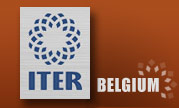The "tokamak" concept
ITER is an experimental fusion reactor based on the "tokamak" concept - a toroidal (doughnut-shaped) magnetic configuration in which to create and maintain the conditions for controlled fusion reactions.
The overall ITER plant comprises the tokamak, its auxiliaries, and supporting plant facilities. In ITER, superconducting magnet coils around a toroidal vessel confine and control a mix of charged particles - the "plasma" - and induce an electrical current through it. Fusion reactions take place when the plasma is hot enough, dense enough, and contained for long enough for the atomic nuclei in the plasma to start fusing together. The tokamak concept was first developed in Russia and has since been brought to a high level of development in all the major fusion programmes worldwide. To meet its objectives, ITER will be much bigger (twice linear dimensions) than the largest existing tokamak and its expected fusion performance will be many times greater. ITER will be the first machine in which the energy freed by the fusion reactions will significantly exceed the energy required to start the fusion tire. These extrapolations in size and physics performance provide the major challenges to the design of ITER.



